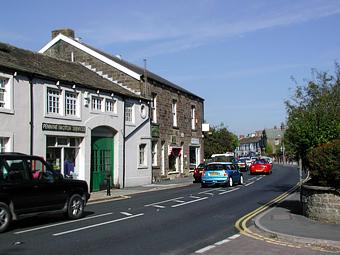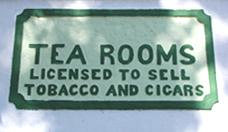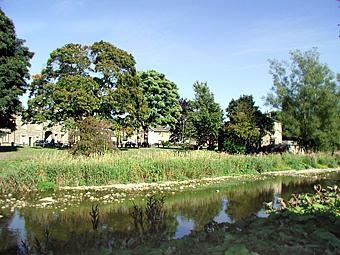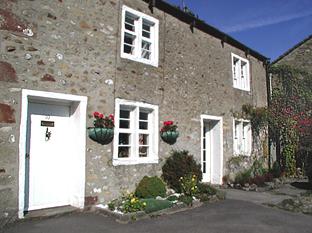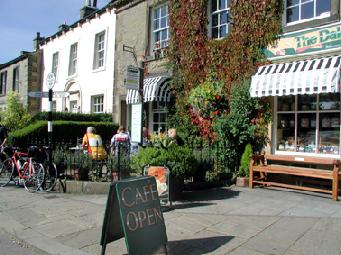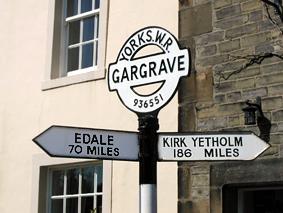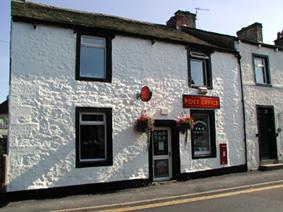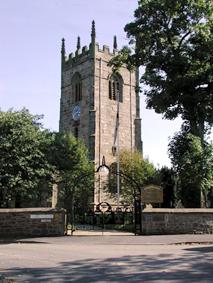Yorksview
|
This picturesque riverside village, on the busy A65 between Skipton and Settle, is mentioned in the Domesday Book and has a happy blending of old and new properties. The Leeds-Settle-Carlisle railway line and Leeds to Liverpool canal together with the Pennine Way all pass through the village, bringing visitors with many different interests. It is well known to weekend motorists who flock into the car parks and take tea in the neat cafes with well-starched tablecloths or tuck into more substantial meals offered by the local hostelries. |
|
|
Sign above house - once a cafe |
In the period following the melting of the Ice Age, huge deposits of rich alluvial soil were dumped by the river Aire and this accounts for the high quality farmland between Gargrave and Skipton. Roman forts existed at Ilkley, Bainbridge and Elslack so it’s hardly surprising to find that a farm villa existed at Gargrave in an area above the present church. This was probably owned by a Romanised native. Very little, if anything, remains of this building, although it is marked prominently on maps. Later, the quality of the land was realised by Cistercian Monks who grew barley and oats. |
| The
River Aire in the village centre is edged by the large green, dotted with
spreading sycamores. Here you can have a picnic, watch grey wagtails and
dippers amongst the stones or search for the many animals to be found in
the lime-rich waters. It is a place where children can play safely.
Spanning the river is a stylish but sturdy stone bridge. You can also
cross to the other side by two sets of ‘Buttertub’ stepping-stones. River Aire |
|
|
Cottages |
Gargrave was once a thriving market town. After the canal was built in the C19th it became a bustling transport centre. Lead from the dales mines was loaded onto barges at one of the five wharves and then returned with coal, corn, glass and other merchandise. Today the canal plays host to pleasure boats. The cotton industry also thrived in the village until 1932. Two mills are now used for residence. When Airebank (Low) Mill closed Gargrave fell into a depression in the early 1930’s. Then Johnson & Johnson took over the building and to this day still produces medical supplies for worldwide distribution. Once, there was a saw mill by the river driven by a water wheel, now restored but not in actual use. Near the site of this mill is an aqueduct – the canal goes over the river, the road goes over the canal and the railway goes over the road. |
|
‘New Brighton’, once a thriving community in its own right, is now an integral part of Gargrave. Nestling behind the railway embankment at the bottom of Marton Road, it began life as a factory producing tennis equipment with a row of cottages built for senior employees. After the war Robert Bros. Circus used it for storing their animals during the winter. The animals could often be heard right across the village. During the 1940’s the factory was demolished making way for a holiday caravan site, cottages and hotels. The parish council restored the ancient summerseat by the river a few years ago. Opposite the summerseat there used to be a watering trough – now marked by a tall lamppost. Amongst others, the trough was used for watering the horses of the gipsies travelling to Appleby Fair. Cafe on main road |
|
|
|
Three pubs remain in the village – The Swan, The Masons Arms and The
Anchor Inn. The Swan was once a main coaching inn, with blacksmiths,
saddler, shoemaker, post office and tailor conveniently to hand.
Sign in the village |
|
Robert Story, the Gargrave schoolmaster-poet, described the village in the 1820's: ‘Situated in the very centre of a district remarkable for its romantic beauty. A bridge, rather elegant and somewhat large for the stream it bestrides, connects the two parts of the village, which would otherwise be separated by the river. On the south side of the river stands the church, the square and tall steeple of which is seen above the trees that surround the quiet burial ground. Along the north side the principal part of the village extends; some of the cottages with clean whitewashed fronts, some covered with ivy or other evergreens and some again with flowering shrubs. A branch of the Queens highway passes through this part of the village, and thus, whilst it detracts something from the seclusion, is the means of making its charms more widely known.’ The Village Post Office |
|
|
|
St
Andrew’s Parish Church has beautiful French stained glass windows and dates
from 1852. The tower, which escaped the disastrous Scots raid of 1318, is
obviously much older. Resting in the peaceful graveyard is Iain McLeod, one
time Chancellor of the Exchequer of Great Britain. His father was the local
doctor. An ancient church dole, known as the Poor Lands Charity, is still
distributed to older residents in December. Within living memory, one family
was refused payment because they owned half a pig! How times have changed. St Andrew's Church |

